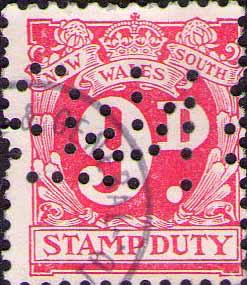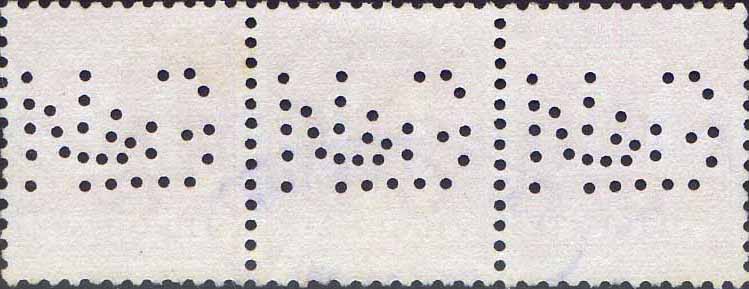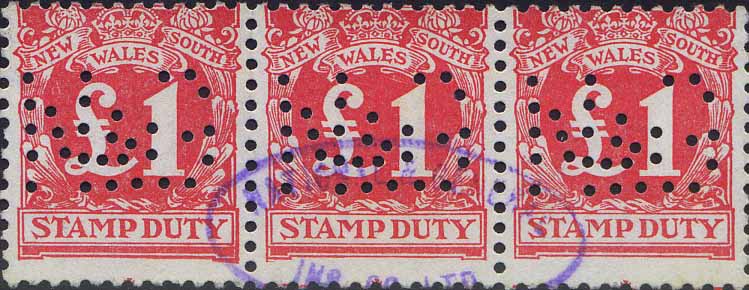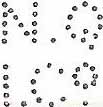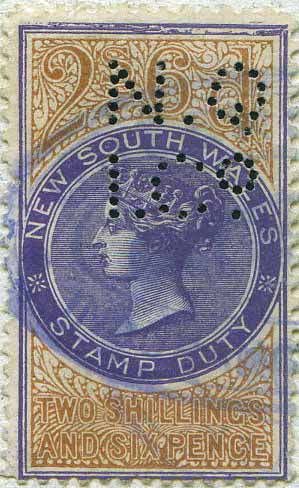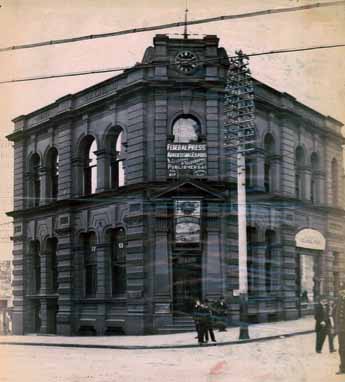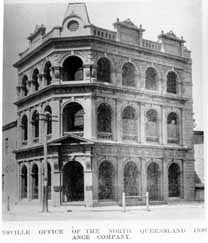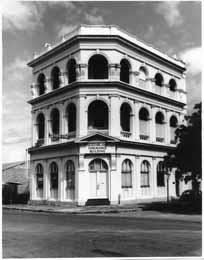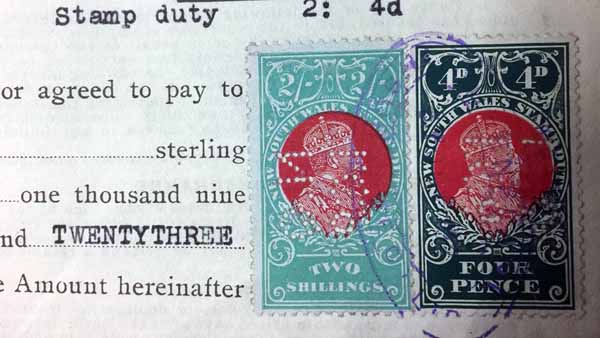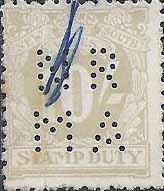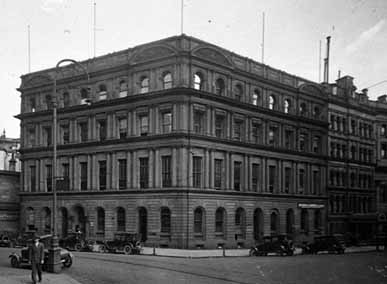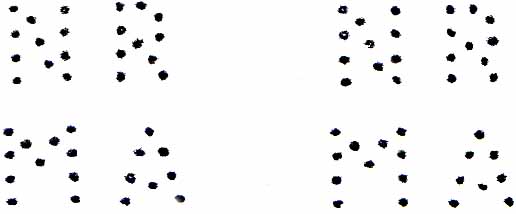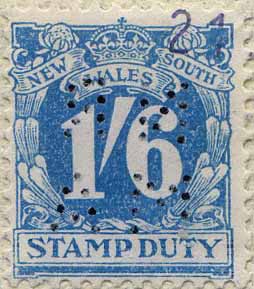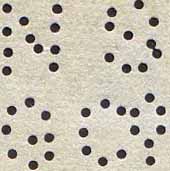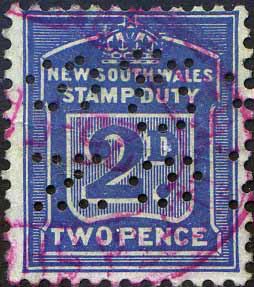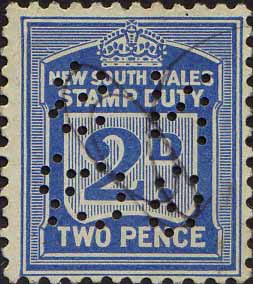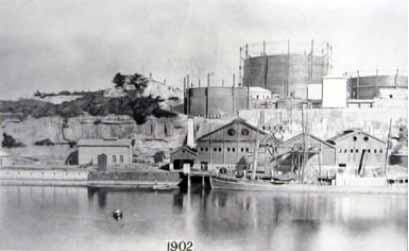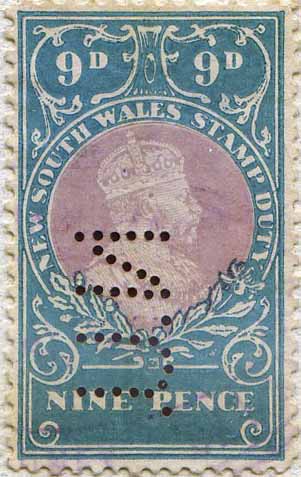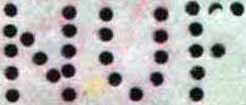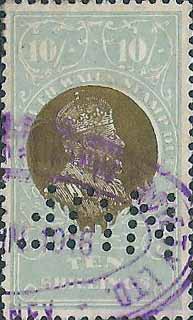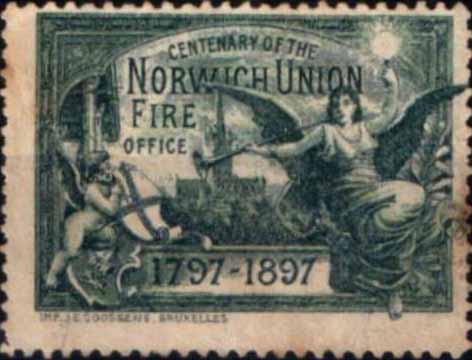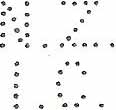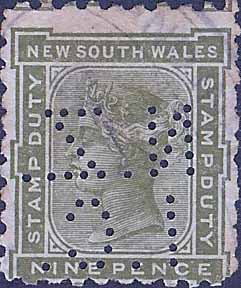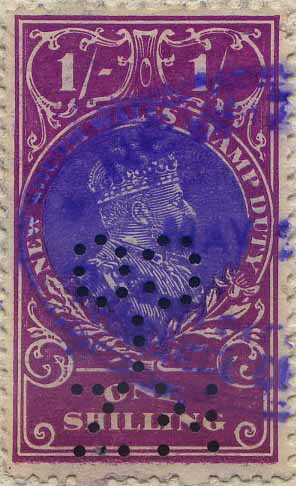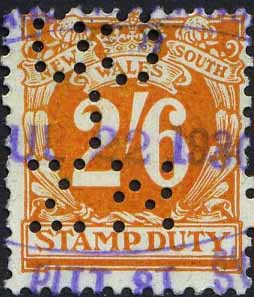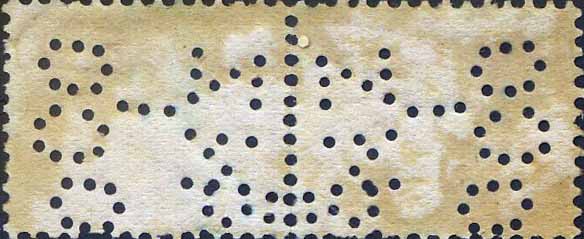|
Private Revenue Perfins of New South Wales An Elsmore Coath production The authors would welcome your comments additions or input into this work A B C D E F G H I J K L M N O P Q R S T U V W Y Other N -------------------------------------------------------- N&G.a
User: National & General Insurance Co Ltd Insurance Provider Address: 126-130 Phillip St, Sydney, NSW Revenue Use: Numeral 1929-66 issue 3d, 6d, 9d, 1/6, 2/-, 2/6, 3/-, 4/-, 5/-, 6/-, 8/-[brown], 10/-, 16/-, 18/-, £1, 30/- Decimal 1966 issue 1c. 4c, 6c, 15c, 40c, 60c, $1 Rarity Scale: Numeral 1929-66 issue 3d, 6d R4, 9d R4, 1/6 R4, 2/- R4, 2/6 R4, 3/- R4, 4/- R4, 5/- 6/- R4, R4, 8/-[brown] R4, 10/- R4, 16/- R4, 18/- R4, £1 R3, 30/- R4 Decimal 1966 issue 1c R4, 4c R4, 6c R4, 15c R4, 40c R4, 60c R4, $1 R4 Background: *The National and General Insurance Co Ltd was formed in October 1954 as a wholly owned subsidiary of Custom Credit Corporation Ltd. At the time of its creation Vanguard Insurance Co. Ltd. was chosen to act as the managing agents for National and General Insurance Co. Ltd and they were most likely co located with Vangauard at their office at 126-130 Phillip St. National and General Insurance was started as a Company to write fire, marine, and general accident business throughout Australia. Custom Credit went onto create a series of other insurance companies, mainly offering Life products. Device: This N&G.a device is only found used on the revenue stamps of NSW and only over the period from about 1960 until 1966. The structure of the device is hard to define as multiples do show consistent relationships between strikes (see example of the joined strip below). However given that all of the strikes in this example have the same missing pin it is more than likely a series of individual strikes from a single die device. This missing pin seems to have been a temporary event as the strikes of N&G.a are consistently good and complete over the life of the device. Related Patterns: Refer to related company patterns in: NSW: V.a Other – Section 2 Commercial Overprints N&G.a *Trove *Wikipedia
-------------------------------------------------------- N.Q/I.Co..a
User: North Queensland Insurance Co Ltd Later, Queensland Insurance Co Ltd Insurance Provider Address: Cnr Bridge & Pitt St just up Bridge St from the Burns Philip building at 11 Bridge St, Sydney, NSW Revenue Use: QV 1872-1908 issue 3d, 6d, 1/-, 1/6, 2/-, 2/6, 3/-, 4/-, 5/-, 6/-, 7/-, 10/-, 15/- QV 1880-1902 issue 3d, 9d KEDVII 1909-28 issue 2d, 3d, 4d, 6d, 8d, 9d, 1/-, 1/6, 2/-, 2/6, 3/-, 4/-, 5/-, 6/-, 7/-, 8/-, 9/-, 10/-, £1 Blue paper 3d, 8d Wmk inverted crown A 4d Underprint 3d Numeral 1917 issue 1d, 2d Rarity Scale: QV 1872-1908 issue 3d R4, 6d R1, 1/- R1, 1/6 R4, 2/- R2, 2/6 R2, 3/- R3, 4/- R3, 5/- R2, 6/- R4, 7/- R4, 10/- R4, 15/- R4 QV 1880-1902 issue 3d R2, 9d R3 KEDVII 1909-28 issue 2d R3, 3d R1, 4d R2, 6d R1, 8d R3, 9d R2, 1/- R1, 1/6 R3, 2/- R1, 2/6 R3, 3/- R2, 4/- R2, 5/- R1, 6/- R4, 7/- R4, 8/- R4, 9/- R4, 10/- R2, £1 R3 Blue paper 3d R4, 8d R1 Wmk crown A inverted 4d R3 Underprint issue 3d R4 Numeral 1917 issue 1d R2, 2d R2 Background: *The North Queensland Insurance Company was established in October 1886 by shipping and trading company, Burns Philip and Co in Sydney and the head office for North Queensland Insurance was established in Townsville (QLD). Initially the companies activities focused on Marine underwriting, but in 1907 it merged with the fellow Burns Phillip subsidiary, the North Queensland Accident Assurance Co. Ltd. Under this broader insurance framework the company grew quickly and soon established offices in all Australian capital cities as well as some regional centres. The company also established overseas offices in New Zealand, England (London), America, Canada, Hong Kong, Burma, Malaya, China (Shanghai), and Japan as well as having agencies in Africa and India. In October 1931 the North Queensland Insurance Co Ltd merged with the Queensland Insurance Co Ltd which seems to have been in existence since the earlier intra company merger in 1907. Queensland Insurance Co Ltd cachets are found on stamps carrying NQIC.a patterns from as early as 1911 which suggests that the relationship with these sister companies was always close. In the early 1970’s the Queensland Insurance company, Bankers and Traders Insurance and Equitable Probate and General Insurance Company merged and were rebadged as QBE Insurance Group. North Queensland Insurance Company office corner of Pitt and Bridge St's, Sydney. The photo shows advertisements for sister companies Oceanic Steamship Co Ltd (A and A Line), and Burns Philip and Co Ltd.
North Queensland Insurance Company first head office corner Wickham and Flinders Streets, Townsville. Left 1901 and right 1965 showing the change to Queensland Insurance. Device: The NQ/ICO.a device is most likely a single die device as it is able to give single central strikes on a variety of stamp formats. The resulting pattern is found on the revenue stamps of NSW as well as the postage stamps of NSW and later those of Australia from 1901 until at least 1924. It is also reported on the postage stamps of Queensland but this is most likely cross State usage that was permitted in around 1912 to use up stocks of State stamps, prior to the issuing of the first Australian stamps in 1913. All evidence suggests that the device was always located in Sydney. By 1923 the device has deteriorated considerably and the N is almost absent, as is much of the Q and it seems that the device was withdrawn from service for repair. When the device returns to service in 1924 the NQI and C have returned in full but it does not have the 'o' of 'Co'. The pins of this repaired device are in the same locations, but are of a slightly thicker format. In some other studies of the commercial perfins of Australia this NQ/IC pattern (without the 'o') has been considered to be a separate pattern and not related to the NQ/IC.a device. This is odd as both the NQ/ICO and the NG/IC patterns are clearly struck from the same device, with identical pin locations, except for the absence of the 'o'. The removal of the 'o' was a logical one as it was a rather small format letter and with its 8 pins it removed a great deal of paper. This sometimes lead to the stamp inside the 'o' to fall out and the pattern appeared to have a small * in lieu of the 'o'. The modification/repair was short lived and usage in 1924 is rare and no later usage is reported. Related patterns: Refer to other related company patterns in: NSW: BP.a B&T.a QI/CO.a QLD: BP.a BP.b BP.c BP.d *Trove *QBE website
4d Worn pattern 1923
A B C A; 'O' of Co pushed out. B; Worn pattern c1923 -------------------------------------------------------- NR/MA.a
User: National Roads & Motorists' Association Automobile Association Address: 3 Spring St, Sydney, NSW Revenue Use: Numeral 1929-66 issue 3d, 6d, 9d, 1/-, 1/6, 2/-, 2/6, 3/-, 4/-, 5/-, 6/-, 8/-, 10/-, 12/-, 14/-, 16/-, 18/-, 18/-[yellow], £1, £5 Decimal 1966 issue 1c, 3c, 4c, 5c, 10c, 15c, 30c, 35c, 40c, 50c, 60c, $1, $1.20, $1.60, $1.80, $2 Rarity Scale: Numeral 1929-66 issue 3d R2, 6d R1, 9d R1, 1/- R1, 1/6 R1, 2/- R1, 2/6 R2, 3/- R1, 4/- R2, 5/- R1, 6/- R1, 8/- R3, 10/- R3, 12/- R1, 14/- R3, 16/- R1, 18/- R3, 18/-[yellow] R3, £1 R3, £5 R3 Decimal 1966 issue 1c R3, 3c R3, 4c R3, 5c R3, 10c R4, 15c R3, 30c R4, 35c R4, 40c R3, 50c R3, 60c R3, $1 R3, $1.20 R4, $1.60 R4, $1.80 R4, $2 R3 Background: *The Royal Automobile Club of Australia (RACA) was formed in 1912 and since its creation it campaigned for better roads. They achieved some success, but legislation tended to see the responsibility for roads fall to Local Government and this did not favour the building of major roads between centres. So in 1920 they formed the Australian National Roads Association (NRA)so as to lobby Government for better major roads. At the beginning of 1924 the NRA was restructured as the National Roads and Motorists' Association (NRMA). The aims of the NRMA were broader and included 'everything necessary for the advancement and protection of motorists'. In this way they came to adopt the more general objectives of their parent body the RACA. The NRMA's membership grew rapidly and by mid 1925 they had 7637 members. As a service to these members they formed an insurance company, NRMA Insurance, and in 1926 this company was reformed as a private mutual company, which as an agent for Lloyds of London was able to offer household policies in addition to motoring insurance. By 1939, the NRMA had 66,234 members and a huge road service and following WWII the RACA and NRMA effectively merged into a single motoring entity. The NRMA continued its growth and success as a motoring organisation and insurance company through the second half of the 20th century, becoming the largest general insurer in Australia. In the 1990’s it was proposed that the NRMA demutualise and after much heated discussion and Government involvement the NRMA partly demutualised in August 2000, forming two separate organisations, the National Roads and Motorists' Association Limited, (which remained a mutual company owned by its members) and NRMA Insurance Limited (which is a listed company owned by its shareholders). NRMA Insurance Limited later became part Insurance Australia Group (IAG). NRMA Insurance as part of IAG operates in NSW, QLD, ACT and TAS. IAG has a broader base with operations throughout Australia, New Zealand, Asia and the United Kingdom. IAG operates some of Australia's leading general insurance brands including NRMA Insurance, CGU, SGIO, SGIC, and Swann Insurance. Hoskins Building at Spring and Gresham St's, purchased in 1932, occupied and later redeveloped for NRMA Insurance. Device: The NRMA device had at least two dies in a horizontal array. The difference between the two dies is discernable so we have listed them as two patterns. These NRMA.a and .b patterns are only found in the revenue stamps of NSW. In both of the previous studies of the private perfins of Australia these patterns were considered to be a single pattern and what is more they were reported to be found on the postage stamps of NSW (CPA 1992) and the postage stamps of Australia (HAPP 2003). These are most likely errors of carelessness by the authors of CPA, as the creation of the NRMA post dates, the issuing of NSW postage stamps and this error was likely 'corrected' in HAPP to refer to the more appropriate, but never the less incorrect, suggestion that they were used on Australian postage stamps. It is interesting to note that in the examples that we have seen that there are more examples of NRMA.a found than that of NRMA.b. This is possibly because the NRMA device had more than two dies and that the 3rd head (or other dies) were very similar to NRMA.a. However, this is not supported by the evidence from multiples that we have seen. It is notable that the usages of NRMA.a and .b do not neatly overlap as you would expect for two dies of a multi die device. Use of NRMA.b is not reported in the 1950’s and only appears on stamps being cachets and dates from the 1960’s. This evidence combined with the higher incidence of NRMA.a supports a theory that the initial device had two dies, both in the style of NRMA.a and that in around 1960 the device was altered/repaired and that this produced the variation to one of the dies that is seen as NRMA.b. This is still a theory and evidence of NRMA.b usage from the 1950’s would require that it be reconsidered. We would welcome any input that would help clarify this matter. Related Patterns: See NR/MA.b *Wikipedia *NRMA Insurance and IAG websites
-------------------------------------------------------- NR/MA.b
User: National Roads & Motorists' Association Automobile Association Address: 3 Spring St, Sydney, NSW Revenue Use: Numeral 1929-66 issue 3d, 6d, 9d, 1/-, 1/6, 2/-, 2/6, 3/-, 5/-, 6/-, 10/-, 12/-, 14/-, 16/-, 18/-, 18/-[yellow], £1, 30/- Decimal 1966 issue 1c, 2c, 3c, 4c, 5c, 10c, 15c, 20c, 30c, 35c, 40c, 50c, 60c, $1, $1.20, $1.40, $1.60, $1.80, $2 Rarity Scale: Numeral 1929-66 issue 3d R1, 6d R1, 9d R2, 1/- R1, 1/6 R1, 2/- R2, 2/6 R2, 3/- R2, 5/- R2, 6/- R2, 10/- R3, 12/- R2, 14/- R1, 16/- R1, 18/- R2, 18/-[yellow] R2, £1 R2, 30/- R4 Decimal 1966 issue 1c R2, 2c R4, 3c R2, 4c R1, 5c R3, 10c R3, 15c R3, 20c R4, 30c R3, 35c R3, 40c R3, 50c R2, 60c R3, $1 R2, $1.20 R2, $1.40 R4, $1.60 R4, $1.80 R4, $2 R2 Background: See NR/MA.a Device: See NR/MA.a Related Patterns: See NR/MA.a -------------------------------------------------------- NS/GCo..a
User: North Shore Gas Co Gas Supplier Address: 193 Alfred St, Sydney, NSW Revenue Use: KEDVII 1909-28 issue 2d Numeral 1929-66 issue 2d R1, 2d[blue paper] R4 Rarity Scale: KEDVII 1909-28 issue 2d R4 Numeral 1917 issue 2d R1 Numeral 1929-66 issue 2d R1 Background: *The North Shore Gas Company was formed in Sydney in 1837 and initially provided gas for street lighting in Sydney from 1841. The company established a large gas works at Neutral Bay in 1876-77 for the purpose of supplying gas to residents of Sydney’s North Shore. The gas was produced from burning coal, so the harbour side location was convenient for coal deliveries by ship. The coal was then taken into the plant via a series of trolleys and overhead tramways. The site was developed in a series of stages in order to respond to Sydney’s growing gas needs. The company operated at the site for about 30 years before moving their operation to a site at Balls Head Bay. The company’s activities at Neutral Bay had done considerable environmental damage to the area. After a series of fires in waste dumps of coal residue the Government had to act to clean up the site. The site was later used as a Naval base in WWII which became the submarine base HMAS Platypus in 1967. In 1999 the submarines were relocated to HMAS Stirling (WA) and the base was closed. The Harbour Trust took over management of the site in 2005. The Balls Head Bay site was not popular with the growing number of residents seeking harbour side locations and the company later moved to a site at Oyster Cove from 1929.
North Shore Gas Company, Neutral Bay, 1902 Device: the NS/GCo.a device is most likely a single die device as it is able to produce central strikes in stamps of a range of sizes and formats. The pattern is found on the revenue stamps of NSW as well as postage stamps of Australia over the period 1916 until at least 1941. On postage stamps North Sydney postmarks predominate. Revenue use is limited to mainly low value (2d) and examples are often found on parts of receipts for payments of gas accounts. Related Patterns: Nil * Trove -------------------------------------------------------- N.U..a
User: Norwich Union Insurance Society Ltd Insurance Provider Address: 'Challis House' Martin Place, Sydney, NSW Revenue Use: KEDVII 1909-28 issue 3d, 6d, 9d, 1/-, 1/6, 2/6, 3/-, 4/-, 5/-, 10/-, 15/-, £1 Rarity Scale: KEDVII 1909-28 issue 3d R4, 6d R4, 9d R4, 1/- R3, 1/6 R3, 2/6 R3, 3/- R3, 4/- R3, 5/- R4, 10/- R4, 15/- R4, £1 R4. Background: *Norwich Union was formed in 1797 in Norwich, England by the merchant and banker Thomas Bignold as the 'Norwich Union Society for the Insurance of Houses, Stock and Merchandise from Fire'. This was later shortened to the Norwich Union Fire Insurance company. The company was created as a mutual society, which meant that it was owned by the policyholders who received a share of the profits. In 1808 Bignold established a second mutual society, the Norwich Union Life Insurance Society and later the Norwich General Assurance Company. By 1821, the Norwich Union Fire Insurance company had 25 fire brigades in cities across England, including Norwich, London, Liverpool, Leeds, Manchester, Exeter and Gloucester. That year the company was restructured and amalgamated with the Norwich General Assurance Company to become the Norwich Union Fire Insurance Society. By 1866 the Norwich Union Fire Insurance company had a branches across England and Ireland. The various Norwich Union Societies continued to grow and by the start of the 20th century they were operating worldwide. In June 1908, by virtue of a private act of parliament the Norwich Union Fire Insurance company became a limited company and from August 1908 was known as the Norwich Union Fire Insurance Society Ltd. In 1920, the Fire Insurance company was purchased by the Phoenix Assurance Company Ltd but in 1925 it was reacquired by the by the Norwich Union Life Insurance Society. Later the combined companies were merged as the Norwich Union Group of Insurance Companies. In 1997 Norwich Union was demutualised and floated as a public limited company on the London Stock Exchange. In 2000, Norwich Union merged with CGU, which itself was formed from the merger of General Accident and Commercial Union in October 1998. The merged company was initially called CGNU but went onto be called Aviva Group although the Norwich Union brand is still used in England but in other parts of the world the company is known as Aviva. Device: The NU.a device is only found used on the revenue stamps of NSW. The device came into service in about 1911 and was used until about 1914. Late usage in 1914 shows many missing or blind pins indicating that the device was in a poor condition. It was a single die device and this is supported by the fact that it can produce central strikes in the larger format Edward VII revenue issues in a variety of positions. In 1916 it was replaced by the NUF.a device. Related Patterns: NSW: LG/A.a NUF.a PAC.a Other – Section 1 Perfins and Cancelling Devices Norwich Union/Fire Office * Wikipedia * Aviva web site -------------------------------------------------------- NUF.a
User: Norwich Union Insurance Society Ltd Insurance Provider Address: 'Challis House' Martin Place, Sydney, NSW Revenue Use: KEDVII 1909-28 issue 2d, 4d, 6d, 8d, 1/-, 1/6, 2/-, 2/6, 3/-, 4/-, 5/-, 6/-, 10/-, £1 Blue paper 4d Wmk crown A 3/-, £1 Underprint issue 1/- Numeral 1917 issue 2d Numeral 1929-66 issue 4d, 6d, 8d, 9d, 1/-, 1/6, 2/-, 2/6, 2/6[orange], 3/-, 4/-, 5/-, 6/-, 8/-[brown], 8/-, 10/-, 12/-, 14/-, 16/-, 18/-, £1, 30/- Rarity Scale: KEDVII 1909-28 issue 2d R3, 4d R2, 6d R4, 8d R2, 1/- R1, 1/6 R3, 2/- R2, 2/6 R3, 3/- R2, 4/- R2, 5/- R1, 6/- R4, 10/- R2, £1 R3 Blue paper 4d R1 Wmk crown A 3/- R4, £1 Underprint issue 1/- R3 Numeral 1917 issue 2d R3 Numeral 1929-66 issue 4d R2, 6d R3, 8d R2, 9d R3, 1/- R1, 1/6 R3, 2/- R2, 2/6 R2, 2/6[orange] R4, 3/- R2, 4/- R4, 5/- R2, 6/- R3, 8/- R3, 8/-[brown] R4, 10/- R3, 12/- R4, 14/- R4, 16/- R4, 18/- R4, £1 R3, 30/- R4 Background: See NU.a above Device: The NUF.a device came into service in the Company's Sydney office in about 1916 and it is found used on the revenue stamps of NSW and less commonly on the postage stamps of Australia. Usage on postage stamps is not reported after the mid 1940’s but the pattern continues to be found on revenue stamps up until at least late 1964. Evidence from multiples indicates that it was a single die device. The NUF pattern is quite long and like many of the devices produced in the 1920’s it was intended for use of the larger format stamps such as the Edward VII revenue issues and the KGV postage stamps. The device was not very suitable for the smaller numeral series and as a result it is often found as a partial or with a full NUF.a pattern but part of the perfin intended for an adjoining stamp. Related Patterns: NSW: LG/A.a NU.a PAC.a Other – Section 1 Perfins and Cancelling Devices Norwich Union/Fire Office. -------------------------------------------------------- N.Z./I.C..a
User: New Zealand Insurance Co (later Ltd) Insurance Provider Address: 38 Bridge St, Sydney, NSW Revenue Use: QV 1872-1908 issue 6d, 1/-, 1/6, 2/-, 2/6, 3/-, 4/-, 5/-, 6/-, 8/-, 10/- QV 1880-1902 issue 3d, 9d Rarity Scale: QV 1872-1908 issue 6d R3, 1/- R2, 1/6 R3, 2/- R3, 2/6 R4, 3/- R3, 4/- R3, 5/- R3, 6/- R4, 8/- R4, 10/- R4 QV 1880-1902 issue 3d R2, 9d R2 Background: *1 The New Zealand Insurance Company was founded in Auckland (NZ) in 1859 and was the first insurance company established in NZ. Its interests were mainly in marine and property insurance and as with other insurance companies of this time, they became involved in the establishment of the early fire brigades in major cities of NZ. The company expanded quickly and by the late 1880’s they had offices throughout New Zealand and Australia as well as London, India, Ceylon, Burma, Cape Colony (and later South Africa), Hong Kong, China, Japan, Argentina and the USA (San Francisco and Honolulu). In 1906 the company was restructured as The New Zealand Insurance Company Ltd and they continued to expand around the world and in Australia establishing offices in Maryborough and Townsville (1907), Rockhampton (1908) and later Cairns. After a series of mergers with other NZ based insurers in the 1980’s including fellow perfin user The Southern British Insurance Co. Ltd., the NZ Insurance group was acquired by General Accident Fire and Life Insurance Corporation in 1989. Following further takeovers and name changes it was eventually disposed of as a trading entity and struck off the New Zealand Register of Companies in 2001. *2 The company lodged many items of historical interest with Archives New Zealand in 1991 including the perforation device NZIC.a which was noted as being recovered from the Maryborough office. A detailed study of the NZ/IC and NZL pattern groups can be found at www.perfins.com.au under the Perfin Research tab. Device: This pattern with its characteristic full stops after each letter is the easiest of the NZ/IC group to identify. Samuel (2010) includes some great detail about it (see pages 73 and 74) including an image of the device (or one of the devices as there may have been a few with the same structure and pattern) and 2 specimen impressions of the pattern. The specimen strikes suggest that it is possible that it was a 2 die device, but if this is the case the dies are so similar as to be the same. The authors would doubt it is anything more than a single die device as it seems to be able to produce good central strikes onto a wide variety of stamp issues of different sizes and this is much easier to achieve with a single die device. Further the separation shown on the specimen strikes is not consistent with the spacing of multiples strikes that we have seen. The usage is widespread and in addition to the use on revenue stamps of NSW in the period from at least 1890 till about 1900, we have seen Queensland revenue and postal use with postmarks and Company cancels from Rockhampton, Maryborough, Charters Towers, Townsville and Brisbane. Much of this usage overlaps so the most likely explanation is that the device was located at a central office (initially Sydney and then later Maryborough or Brisbane) and that perforated stamps were issued to user areas from this office. This is the method adopted by larger users such as State Governments. Alternatively the evidence of remote usage across Queensland, as well as in Sydney, in the same period could have been achieved by multiple devices with identical dies. However this is an early device (1880’s) and given the standards of manufacturer at this time it would have been a challenge to produce a series of identical dies. The pattern is found on the revenue stamps of NSW as well as the revenue stamps of Queensland and the postage stamps of Queensland and Australia between 1889/90-1934. Related patterns: Refer to other New Zealand Insurance Company patterns in: NSW: NZ/I/CO.a QLD: NZ/IC.a NZ/IC.b NZ/IC.c NZ/IC.d NZ/IC.e NZ/IC.f NZ/IC.g *1 Bold Century 'The New Zealand Insurance Company Ltd' 1859-1959 *2 'New Zealand Stamps with Perforated Initials'. RD Samuel 2010 -------------------------------------------------------- NZ/I/CO.a
User: New Zealand Insurance Co Insurance Provider Address: 79-81 Pitt St, Sydney, NSW Revenue Use: KEDVII 1909-28 issue 4d, 1/-, 3/-, 6/-, 7/-, 8/- Numeral 1929-66 issue 2d, 3d, 3d[no wmk], 4d, 6d, 8d, 9d, 1/-, 1/6, 2/-, 2/-[no wmk], 2/6, 2/6[orange], 3/-, 4/-, 4/-[no wmk], 5/-, 6/-, 10/-, 14/-, £1, 30/-, £5, £10 Decimal 1966 issue 2c, 4c, 5c, 15c, 20c, 50c, 80c, $1, $1.20, $1.40, $2, $3, $10 Rarity Scale: KEDVII 1909-28 issue 4d R4, 1/- R4, 3/- R4, 6/- R4, 7/- R4, 8/- R4 Numeral 1929-66 issue 2d R3, 3d R3, 3d[no wmk] R2, 4d R3, 6d R3, 8d R3, 9d R3, 1/- R2, 1/6 R2, 2/- R2, 2/-[no wmk] R4, 2/6 R3, 2/6[orange] R4, 3/- R3, 4/- R3, 4/-[no wmk] R4, 5/- R3, 6/- R4, 10/- R1, 14/- R4, £1 R2, 30/- R4, £5 R4, £10 R4 Decimal 1966 issue 2c R4, 4c R4, 5c R4, 15c R4, 20c R4, 50c R4, 80c R4, $1 R4, $1.20 R4, $1.40 R4, $2 R3, $3 R4, $10 R4 Background: See N.Z./I.C..a above Interestingly some later examples of the NZ/I/CO.a pattern (1965-1966) are found with cachets of the MLC Fire & General Insurance Company Pty Ltd. This indicates that New Zealand Insurance Company Ltd may have been acquired by MLC at this time. Such acquisitions were common during the later half of the 20th century and companies frequently continued to trade under their existing names despite changes of ownership. Device: The NZ/I/CO.a device was most likely a single die device as multiples strikes do not show a consistent relationship to each other. The pattern is quite large and laid out over 3 rows of letters. It is found used, albeit rarely, on the large format Edward VII revenues of NSW, and it appears that the device was designed for use on these issues. However the NSW Government introduced the smaller numeral series in 1929 and the device is less suited to these smaller format issues. Accordingly you will often find partial strikes on these numeral issues. This NZ/I/CO.a pattern is only found on revenue stamps of NSW and only in the period 1928-1966. In previous studies of the private perfins of Australia the address for the company during the use of this device has been stated to be 117 Pitt St, Sydney. This is not supported by our research which has found all readable company cachets to indicate that the address was 79-81 Pitt St as stated above. Interestingly some later examples of the NZ/I/CO.a pattern (1965-1966) are found with cachets of the MLC Fire & General Insurance Company Pty Ltd. This indicates that New Zealand Insurance Company Ltd may have been acquired by MLC at this time. Such acquisitions were common during the later half of the 20th century and companies frequently continued to trade under their existing names despite changes of ownership. Related patterns: Refer to other New Zealand Insurance Company patterns in: NSW: NZ/IC.a QLD: NZ/IC.a NZ/IC.b NZ/IC.c NZ/IC.d NZ/IC.e NZ/IC.f NZ/IC.g
-------------------------------------------------------- A B C D E F G H I J K L M N O P Q R S T U V W Y Other © copyright 2011 |

